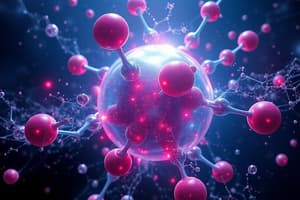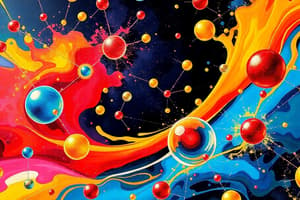Podcast
Questions and Answers
According to the kinetic molecular model, what is the relationship between the speed of particles and the temperature of a substance?
According to the kinetic molecular model, what is the relationship between the speed of particles and the temperature of a substance?
- The speed of particles is independent of the temperature of a substance.
- The speed of particles is inversely proportional to the temperature of a substance.
- The speed of particles is exponentially related to the temperature of a substance.
- The speed of particles is directly proportional to the temperature of a substance. (correct)
Which of the following is NOT a premise of the kinetic molecular model?
Which of the following is NOT a premise of the kinetic molecular model?
- There are forces of attraction and repulsion between particles.
- Particles are in constant random motion.
- There are no spaces between particles. (correct)
- All matter consists of particles.
What is the meaning of the word 'Kinetic' in the context of the kinetic molecular model?
What is the meaning of the word 'Kinetic' in the context of the kinetic molecular model?
- Relating to temperature.
- Relating to particles.
- Relating to motion. (correct)
- Relating to energy.
What is the relationship between the kinetic molecular model and the phases of matter (solid, liquid, gas)?
What is the relationship between the kinetic molecular model and the phases of matter (solid, liquid, gas)?
What does the term 'intermolecular forces' refer to in the context of the kinetic molecular model?
What does the term 'intermolecular forces' refer to in the context of the kinetic molecular model?
If a material is heated up enough, what would happen to the particles?
If a material is heated up enough, what would happen to the particles?
When substances change from a gas to a liquid, would the particles become more or less organized?
When substances change from a gas to a liquid, would the particles become more or less organized?
According to the Kinetic Molecular Model, which of the following can be attributed to the change in phase of a substance?
According to the Kinetic Molecular Model, which of the following can be attributed to the change in phase of a substance?
Which of the following is a result of the increased kinetic energy of particles?
Which of the following is a result of the increased kinetic energy of particles?
Which of the following best describes the intermolecular forces between particles in a solid?
Which of the following best describes the intermolecular forces between particles in a solid?
Which of the following best describes the relationship between the motion of molecules and the intermolecular forces?
Which of the following best describes the relationship between the motion of molecules and the intermolecular forces?
Which phase of matter has a definite volume but an indefinite shape?
Which phase of matter has a definite volume but an indefinite shape?
Which of the following accurately describes the relationship between density and the state of matter?
Which of the following accurately describes the relationship between density and the state of matter?
Which intermolecular force is considered the weakest?
Which intermolecular force is considered the weakest?
What distinguishes Dipole-Dipole Interactions from London Dispersion Forces?
What distinguishes Dipole-Dipole Interactions from London Dispersion Forces?
Which statement is true about Hydrogen Bonds?
Which statement is true about Hydrogen Bonds?
How do London Dispersion Forces change with the number of electrons in a molecule?
How do London Dispersion Forces change with the number of electrons in a molecule?
Which elements must be present for Hydrogen Bonds to occur?
Which elements must be present for Hydrogen Bonds to occur?
What is a characteristic effect of polarity in liquids?
What is a characteristic effect of polarity in liquids?
Which of the following statements regarding Bromine and Chlorine is correct?
Which of the following statements regarding Bromine and Chlorine is correct?
What causes a dipole moment in a molecule?
What causes a dipole moment in a molecule?
Flashcards
Kinetic Molecular Model
Kinetic Molecular Model
A model describing matter as made up of particles in constant motion.
Intermolecular Forces
Intermolecular Forces
Forces of attraction or repulsion between molecules.
Viscosity
Viscosity
A measure of a liquid's resistance to flow.
Properties of Liquids
Properties of Liquids
Signup and view all the flashcards
Phase of Matter
Phase of Matter
Signup and view all the flashcards
London Dispersion Forces
London Dispersion Forces
Signup and view all the flashcards
Dipole-Dipole Interactions
Dipole-Dipole Interactions
Signup and view all the flashcards
Hydrogen Bonds
Hydrogen Bonds
Signup and view all the flashcards
Boiling Point Comparison
Boiling Point Comparison
Signup and view all the flashcards
Dipole Moment
Dipole Moment
Signup and view all the flashcards
Polarity and Miscibility
Polarity and Miscibility
Signup and view all the flashcards
Permanent Dipole
Permanent Dipole
Signup and view all the flashcards
Solid
Solid
Signup and view all the flashcards
Liquid
Liquid
Signup and view all the flashcards
Gas
Gas
Signup and view all the flashcards
Melting
Melting
Signup and view all the flashcards
Vaporization
Vaporization
Signup and view all the flashcards
Sublimation
Sublimation
Signup and view all the flashcards
Study Notes
Module 1: Kinetic Molecular Models of Liquids and Solids
- This module focuses on the kinetic molecular model to understand the properties of liquids and solids.
Objectives
- Students will be able to use the kinetic molecular model to explain liquid and solid properties.
- Identify and differentiate types of intermolecular forces.
- Predict intermolecular forces within molecules.
- Explain the effect of intermolecular forces on liquid properties.
- Describe water properties based on its molecular structure and intermolecular forces.
- Measure and explain viscosity differences in liquids.
- Understand the role and importance of intermolecular forces in interactions between matter phases.
Kinetic Molecular Model
- The term "kinetic" comes from the Greek word "kinein," meaning to move.
- Particle speed is directly proportional to temperature. Higher temperatures mean faster particle movement.
- The phase of a substance depends on the kinetic energy of its particles and the intermolecular forces between them.
Kinetic Particle Theory
- All matter consists of particles.
- Particles are in constant, random motion.
- There are spaces between particles.
- There are attractive and repulsive forces between particles.
Particle Description of Each Phase of Matter
| Criterion | Solid | Liquid | Gas |
|---|---|---|---|
| Molecular arrangements | Closely packed | Slightly spaced from each other | Widely dispersed |
| Volume/Shape | Definite volume and shape | Definite volume, takes the shape of container | Indefinite volume and shape |
| Density | High | High | Low |
| Motion of Molecules | Vibration in place | Random movement | Fast, random movement |
Kinetic Molecular Model (Continued)
- When solids or liquids are heated, kinetic energy increases, causing particles to move faster.
- At higher temperatures, particle movement overcomes intermolecular forces, and phases change (e.g., melting, vaporization, sublimation).
- Solids can melt or sublime; liquids can vaporize. Specific temperatures, such as freezing points and boiling points, are associated with phase changes.
Phase Changes
- Solidification/Freezing (liquid to solid)
- Melting (solid to liquid)
- Vaporization (liquid to gas)
- Sublimation (solid to gas)
- Condensation (gas to liquid)
- Deposition (gas to solid)
- Ionization/Deionization
- Plasma (a highly energized state of matter)
Intermolecular Forces
- Forces of attraction between atoms, molecules, or ions.
- Significantly weaker than intramolecular forces (forces holding atoms together within molecules).
- Types of intermolecular forces (weakest to strongest):
- London Dispersion Forces (temporary dipoles)
- Dipole-Dipole Interactions (polar molecules)
- Hydrogen Bonds (strong dipole-dipole interactions involving H, F, O, or N)
London Dispersion Forces (LDFs)
- Weakest intermolecular force.
- Present in all molecules, regardless of polarity.
- Strength depends on the number of electrons in a molecule. More electrons mean stronger LDFs.
- Higher boiling points correlate with stronger LDFs.
Dipole-Dipole Interactions
- Stronger than LDFs.
- Occur in polar molecules due to permanent dipole moments (uneven charge distribution).
- The greater the polarity, the stronger the dipole-dipole interaction.
- Polarity affects miscibility (ability to mix). Polar substances tend to mix with other polar substances.
Hydrogen Bonds
- Strongest type of intermolecular force.
- Involve hydrogen bonded to highly electronegative atoms (F, O, N).
- Crucial in many biological processes and the properties of water.
Studying That Suits You
Use AI to generate personalized quizzes and flashcards to suit your learning preferences.




